Role of a Nurse in Chronic Illness Management
VerifiedAdded on 2023/06/03
|15
|4513
|74
AI Summary
This essay discusses the pathophysiology of chronic illness, how the signs and symptoms affect a person’s life, and the role of a nurse in delivering inter professional person centered care, promoting self-management and response to changing patient needs. The chosen chronic condition is myocardial infarction (MI) in women of age group 60-70 years.
Contribute Materials
Your contribution can guide someone’s learning journey. Share your
documents today.
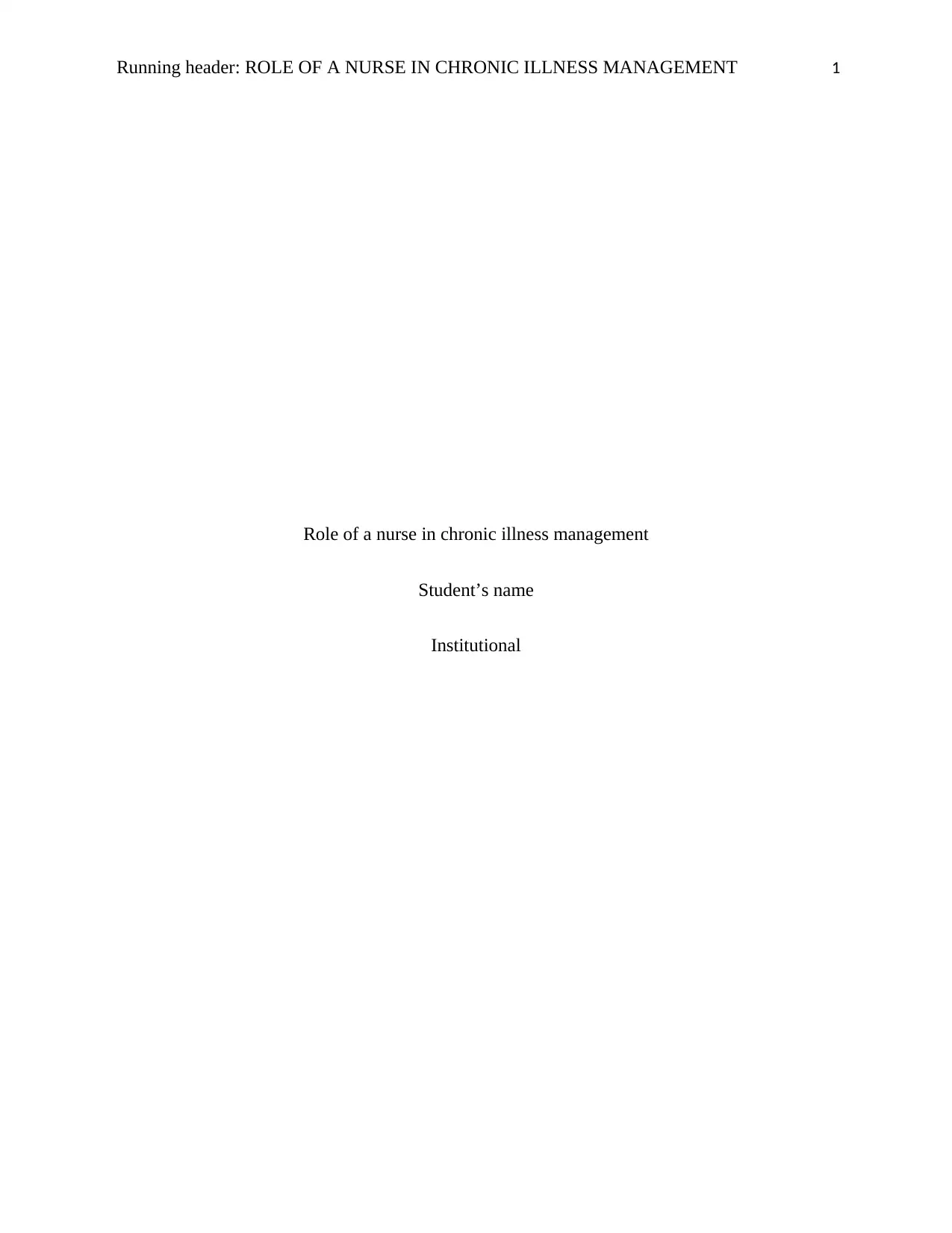
Running header: ROLE OF A NURSE IN CHRONIC ILLNESS MANAGEMENT 1
Role of a nurse in chronic illness management
Student’s name
Institutional
Role of a nurse in chronic illness management
Student’s name
Institutional
Secure Best Marks with AI Grader
Need help grading? Try our AI Grader for instant feedback on your assignments.
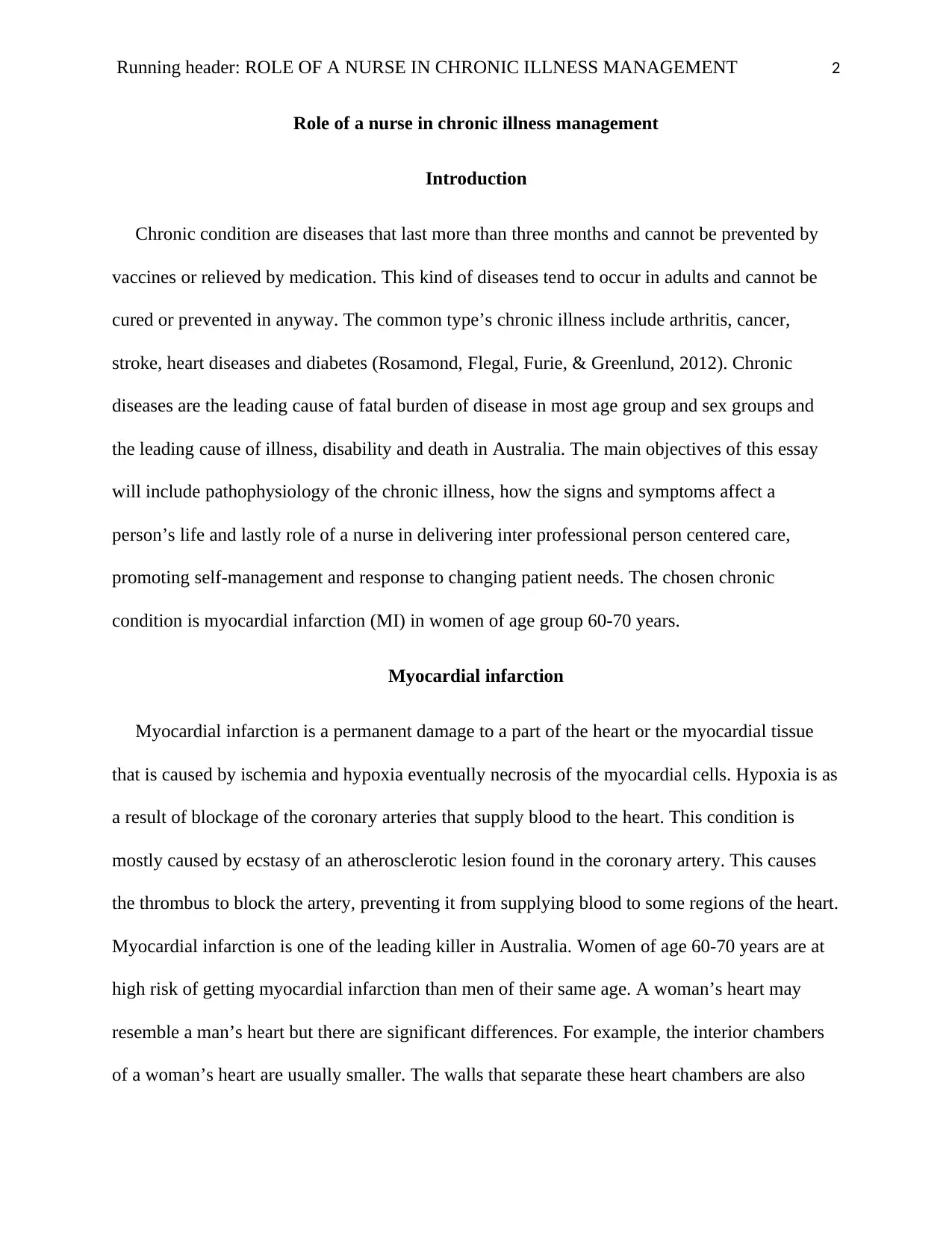
Running header: ROLE OF A NURSE IN CHRONIC ILLNESS MANAGEMENT 2
Role of a nurse in chronic illness management
Introduction
Chronic condition are diseases that last more than three months and cannot be prevented by
vaccines or relieved by medication. This kind of diseases tend to occur in adults and cannot be
cured or prevented in anyway. The common type’s chronic illness include arthritis, cancer,
stroke, heart diseases and diabetes (Rosamond, Flegal, Furie, & Greenlund, 2012). Chronic
diseases are the leading cause of fatal burden of disease in most age group and sex groups and
the leading cause of illness, disability and death in Australia. The main objectives of this essay
will include pathophysiology of the chronic illness, how the signs and symptoms affect a
person’s life and lastly role of a nurse in delivering inter professional person centered care,
promoting self-management and response to changing patient needs. The chosen chronic
condition is myocardial infarction (MI) in women of age group 60-70 years.
Myocardial infarction
Myocardial infarction is a permanent damage to a part of the heart or the myocardial tissue
that is caused by ischemia and hypoxia eventually necrosis of the myocardial cells. Hypoxia is as
a result of blockage of the coronary arteries that supply blood to the heart. This condition is
mostly caused by ecstasy of an atherosclerotic lesion found in the coronary artery. This causes
the thrombus to block the artery, preventing it from supplying blood to some regions of the heart.
Myocardial infarction is one of the leading killer in Australia. Women of age 60-70 years are at
high risk of getting myocardial infarction than men of their same age. A woman’s heart may
resemble a man’s heart but there are significant differences. For example, the interior chambers
of a woman’s heart are usually smaller. The walls that separate these heart chambers are also
Role of a nurse in chronic illness management
Introduction
Chronic condition are diseases that last more than three months and cannot be prevented by
vaccines or relieved by medication. This kind of diseases tend to occur in adults and cannot be
cured or prevented in anyway. The common type’s chronic illness include arthritis, cancer,
stroke, heart diseases and diabetes (Rosamond, Flegal, Furie, & Greenlund, 2012). Chronic
diseases are the leading cause of fatal burden of disease in most age group and sex groups and
the leading cause of illness, disability and death in Australia. The main objectives of this essay
will include pathophysiology of the chronic illness, how the signs and symptoms affect a
person’s life and lastly role of a nurse in delivering inter professional person centered care,
promoting self-management and response to changing patient needs. The chosen chronic
condition is myocardial infarction (MI) in women of age group 60-70 years.
Myocardial infarction
Myocardial infarction is a permanent damage to a part of the heart or the myocardial tissue
that is caused by ischemia and hypoxia eventually necrosis of the myocardial cells. Hypoxia is as
a result of blockage of the coronary arteries that supply blood to the heart. This condition is
mostly caused by ecstasy of an atherosclerotic lesion found in the coronary artery. This causes
the thrombus to block the artery, preventing it from supplying blood to some regions of the heart.
Myocardial infarction is one of the leading killer in Australia. Women of age 60-70 years are at
high risk of getting myocardial infarction than men of their same age. A woman’s heart may
resemble a man’s heart but there are significant differences. For example, the interior chambers
of a woman’s heart are usually smaller. The walls that separate these heart chambers are also
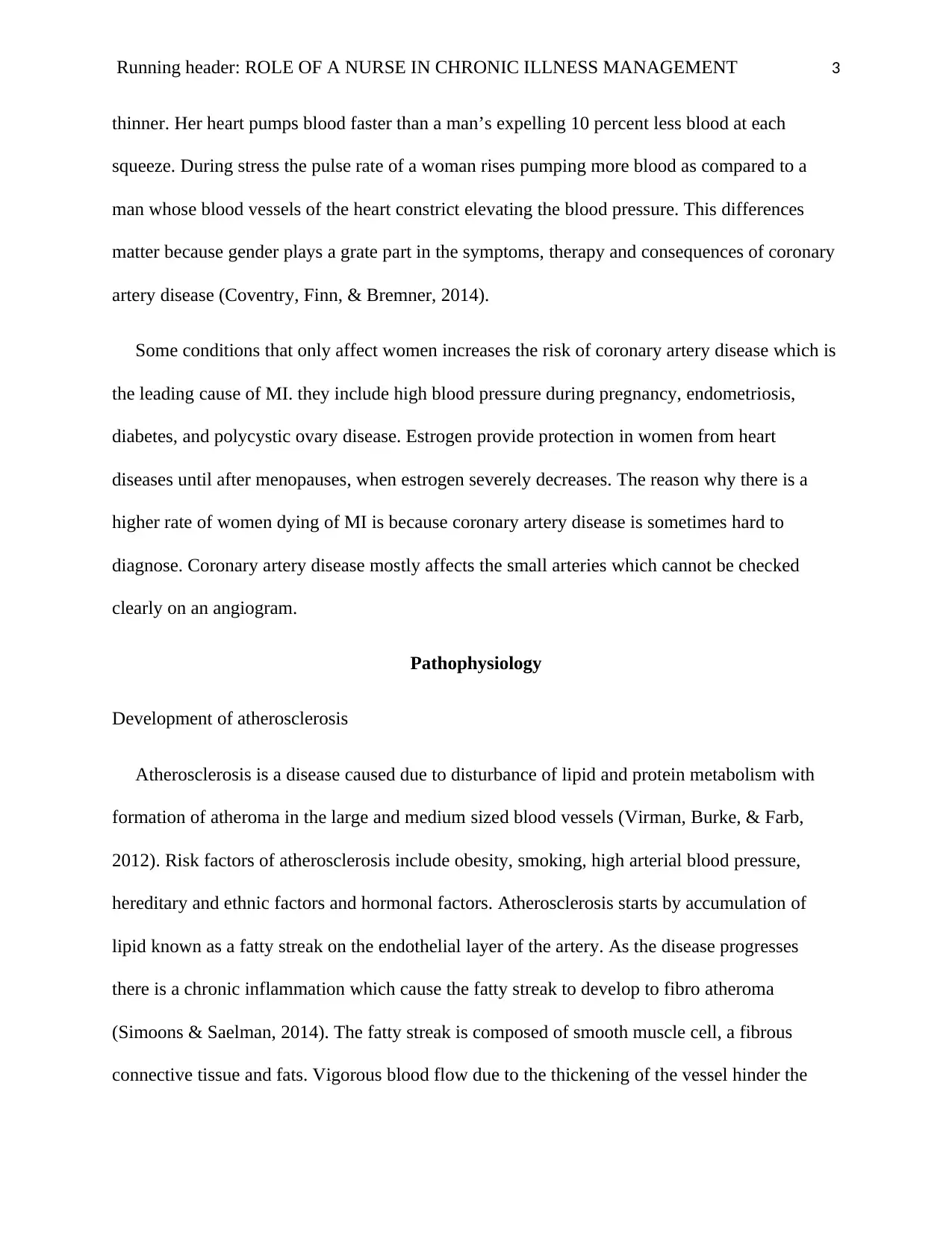
Running header: ROLE OF A NURSE IN CHRONIC ILLNESS MANAGEMENT 3
thinner. Her heart pumps blood faster than a man’s expelling 10 percent less blood at each
squeeze. During stress the pulse rate of a woman rises pumping more blood as compared to a
man whose blood vessels of the heart constrict elevating the blood pressure. This differences
matter because gender plays a grate part in the symptoms, therapy and consequences of coronary
artery disease (Coventry, Finn, & Bremner, 2014).
Some conditions that only affect women increases the risk of coronary artery disease which is
the leading cause of MI. they include high blood pressure during pregnancy, endometriosis,
diabetes, and polycystic ovary disease. Estrogen provide protection in women from heart
diseases until after menopauses, when estrogen severely decreases. The reason why there is a
higher rate of women dying of MI is because coronary artery disease is sometimes hard to
diagnose. Coronary artery disease mostly affects the small arteries which cannot be checked
clearly on an angiogram.
Pathophysiology
Development of atherosclerosis
Atherosclerosis is a disease caused due to disturbance of lipid and protein metabolism with
formation of atheroma in the large and medium sized blood vessels (Virman, Burke, & Farb,
2012). Risk factors of atherosclerosis include obesity, smoking, high arterial blood pressure,
hereditary and ethnic factors and hormonal factors. Atherosclerosis starts by accumulation of
lipid known as a fatty streak on the endothelial layer of the artery. As the disease progresses
there is a chronic inflammation which cause the fatty streak to develop to fibro atheroma
(Simoons & Saelman, 2014). The fatty streak is composed of smooth muscle cell, a fibrous
connective tissue and fats. Vigorous blood flow due to the thickening of the vessel hinder the
thinner. Her heart pumps blood faster than a man’s expelling 10 percent less blood at each
squeeze. During stress the pulse rate of a woman rises pumping more blood as compared to a
man whose blood vessels of the heart constrict elevating the blood pressure. This differences
matter because gender plays a grate part in the symptoms, therapy and consequences of coronary
artery disease (Coventry, Finn, & Bremner, 2014).
Some conditions that only affect women increases the risk of coronary artery disease which is
the leading cause of MI. they include high blood pressure during pregnancy, endometriosis,
diabetes, and polycystic ovary disease. Estrogen provide protection in women from heart
diseases until after menopauses, when estrogen severely decreases. The reason why there is a
higher rate of women dying of MI is because coronary artery disease is sometimes hard to
diagnose. Coronary artery disease mostly affects the small arteries which cannot be checked
clearly on an angiogram.
Pathophysiology
Development of atherosclerosis
Atherosclerosis is a disease caused due to disturbance of lipid and protein metabolism with
formation of atheroma in the large and medium sized blood vessels (Virman, Burke, & Farb,
2012). Risk factors of atherosclerosis include obesity, smoking, high arterial blood pressure,
hereditary and ethnic factors and hormonal factors. Atherosclerosis starts by accumulation of
lipid known as a fatty streak on the endothelial layer of the artery. As the disease progresses
there is a chronic inflammation which cause the fatty streak to develop to fibro atheroma
(Simoons & Saelman, 2014). The fatty streak is composed of smooth muscle cell, a fibrous
connective tissue and fats. Vigorous blood flow due to the thickening of the vessel hinder the
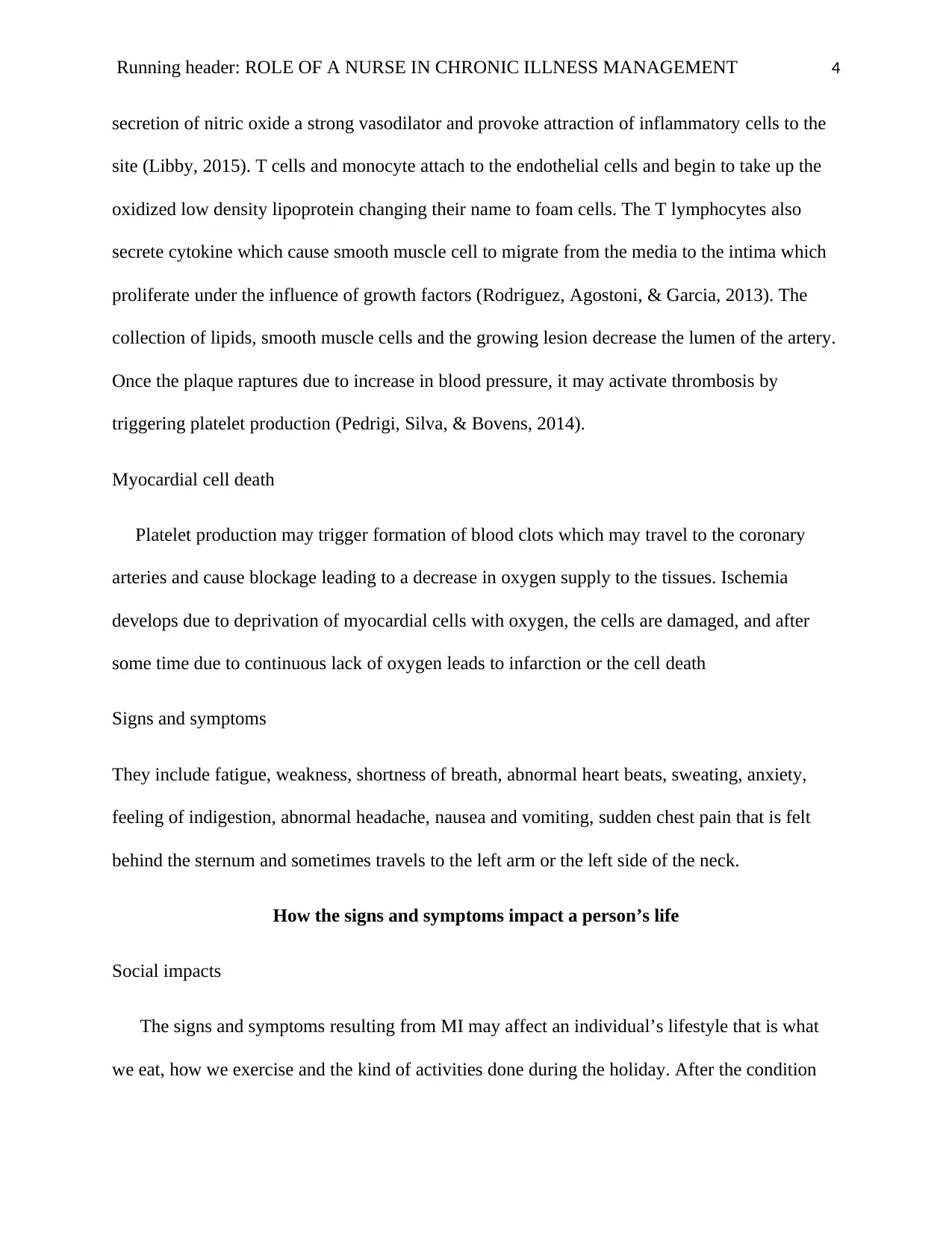
Running header: ROLE OF A NURSE IN CHRONIC ILLNESS MANAGEMENT 4
secretion of nitric oxide a strong vasodilator and provoke attraction of inflammatory cells to the
site (Libby, 2015). T cells and monocyte attach to the endothelial cells and begin to take up the
oxidized low density lipoprotein changing their name to foam cells. The T lymphocytes also
secrete cytokine which cause smooth muscle cell to migrate from the media to the intima which
proliferate under the influence of growth factors (Rodriguez, Agostoni, & Garcia, 2013). The
collection of lipids, smooth muscle cells and the growing lesion decrease the lumen of the artery.
Once the plaque raptures due to increase in blood pressure, it may activate thrombosis by
triggering platelet production (Pedrigi, Silva, & Bovens, 2014).
Myocardial cell death
Platelet production may trigger formation of blood clots which may travel to the coronary
arteries and cause blockage leading to a decrease in oxygen supply to the tissues. Ischemia
develops due to deprivation of myocardial cells with oxygen, the cells are damaged, and after
some time due to continuous lack of oxygen leads to infarction or the cell death
Signs and symptoms
They include fatigue, weakness, shortness of breath, abnormal heart beats, sweating, anxiety,
feeling of indigestion, abnormal headache, nausea and vomiting, sudden chest pain that is felt
behind the sternum and sometimes travels to the left arm or the left side of the neck.
How the signs and symptoms impact a person’s life
Social impacts
The signs and symptoms resulting from MI may affect an individual’s lifestyle that is what
we eat, how we exercise and the kind of activities done during the holiday. After the condition
secretion of nitric oxide a strong vasodilator and provoke attraction of inflammatory cells to the
site (Libby, 2015). T cells and monocyte attach to the endothelial cells and begin to take up the
oxidized low density lipoprotein changing their name to foam cells. The T lymphocytes also
secrete cytokine which cause smooth muscle cell to migrate from the media to the intima which
proliferate under the influence of growth factors (Rodriguez, Agostoni, & Garcia, 2013). The
collection of lipids, smooth muscle cells and the growing lesion decrease the lumen of the artery.
Once the plaque raptures due to increase in blood pressure, it may activate thrombosis by
triggering platelet production (Pedrigi, Silva, & Bovens, 2014).
Myocardial cell death
Platelet production may trigger formation of blood clots which may travel to the coronary
arteries and cause blockage leading to a decrease in oxygen supply to the tissues. Ischemia
develops due to deprivation of myocardial cells with oxygen, the cells are damaged, and after
some time due to continuous lack of oxygen leads to infarction or the cell death
Signs and symptoms
They include fatigue, weakness, shortness of breath, abnormal heart beats, sweating, anxiety,
feeling of indigestion, abnormal headache, nausea and vomiting, sudden chest pain that is felt
behind the sternum and sometimes travels to the left arm or the left side of the neck.
How the signs and symptoms impact a person’s life
Social impacts
The signs and symptoms resulting from MI may affect an individual’s lifestyle that is what
we eat, how we exercise and the kind of activities done during the holiday. After the condition
Secure Best Marks with AI Grader
Need help grading? Try our AI Grader for instant feedback on your assignments.
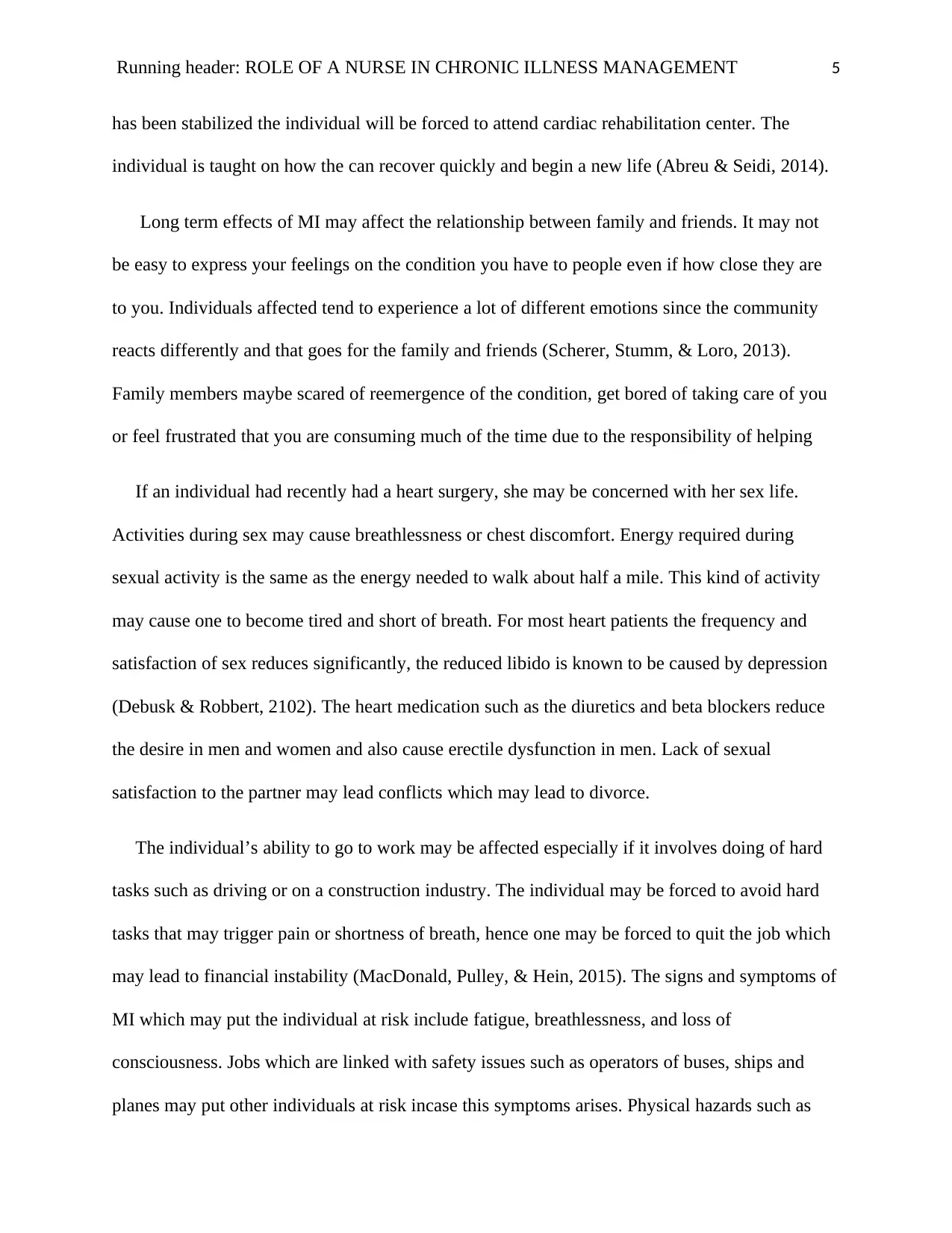
Running header: ROLE OF A NURSE IN CHRONIC ILLNESS MANAGEMENT 5
has been stabilized the individual will be forced to attend cardiac rehabilitation center. The
individual is taught on how the can recover quickly and begin a new life (Abreu & Seidi, 2014).
Long term effects of MI may affect the relationship between family and friends. It may not
be easy to express your feelings on the condition you have to people even if how close they are
to you. Individuals affected tend to experience a lot of different emotions since the community
reacts differently and that goes for the family and friends (Scherer, Stumm, & Loro, 2013).
Family members maybe scared of reemergence of the condition, get bored of taking care of you
or feel frustrated that you are consuming much of the time due to the responsibility of helping
If an individual had recently had a heart surgery, she may be concerned with her sex life.
Activities during sex may cause breathlessness or chest discomfort. Energy required during
sexual activity is the same as the energy needed to walk about half a mile. This kind of activity
may cause one to become tired and short of breath. For most heart patients the frequency and
satisfaction of sex reduces significantly, the reduced libido is known to be caused by depression
(Debusk & Robbert, 2102). The heart medication such as the diuretics and beta blockers reduce
the desire in men and women and also cause erectile dysfunction in men. Lack of sexual
satisfaction to the partner may lead conflicts which may lead to divorce.
The individual’s ability to go to work may be affected especially if it involves doing of hard
tasks such as driving or on a construction industry. The individual may be forced to avoid hard
tasks that may trigger pain or shortness of breath, hence one may be forced to quit the job which
may lead to financial instability (MacDonald, Pulley, & Hein, 2015). The signs and symptoms of
MI which may put the individual at risk include fatigue, breathlessness, and loss of
consciousness. Jobs which are linked with safety issues such as operators of buses, ships and
planes may put other individuals at risk incase this symptoms arises. Physical hazards such as
has been stabilized the individual will be forced to attend cardiac rehabilitation center. The
individual is taught on how the can recover quickly and begin a new life (Abreu & Seidi, 2014).
Long term effects of MI may affect the relationship between family and friends. It may not
be easy to express your feelings on the condition you have to people even if how close they are
to you. Individuals affected tend to experience a lot of different emotions since the community
reacts differently and that goes for the family and friends (Scherer, Stumm, & Loro, 2013).
Family members maybe scared of reemergence of the condition, get bored of taking care of you
or feel frustrated that you are consuming much of the time due to the responsibility of helping
If an individual had recently had a heart surgery, she may be concerned with her sex life.
Activities during sex may cause breathlessness or chest discomfort. Energy required during
sexual activity is the same as the energy needed to walk about half a mile. This kind of activity
may cause one to become tired and short of breath. For most heart patients the frequency and
satisfaction of sex reduces significantly, the reduced libido is known to be caused by depression
(Debusk & Robbert, 2102). The heart medication such as the diuretics and beta blockers reduce
the desire in men and women and also cause erectile dysfunction in men. Lack of sexual
satisfaction to the partner may lead conflicts which may lead to divorce.
The individual’s ability to go to work may be affected especially if it involves doing of hard
tasks such as driving or on a construction industry. The individual may be forced to avoid hard
tasks that may trigger pain or shortness of breath, hence one may be forced to quit the job which
may lead to financial instability (MacDonald, Pulley, & Hein, 2015). The signs and symptoms of
MI which may put the individual at risk include fatigue, breathlessness, and loss of
consciousness. Jobs which are linked with safety issues such as operators of buses, ships and
planes may put other individuals at risk incase this symptoms arises. Physical hazards such as

Running header: ROLE OF A NURSE IN CHRONIC ILLNESS MANAGEMENT 6
intense heat or cold have increased the risk of cardiovascular issues since it increases the risk of
ischemia in an individual with a history of coronary vascular disease. Other hazards such
prolonged exposure to a noisy environment may trigger a blood pressure elevation.
Emotional impacts
Patients with MI frequently fear loss of their roles within the family and society. The fear is
that the condition may lead to death. Fear may lead to anxiety which may worsen MI. The other
factor that may cause stress is financial problems, the individuals having resigned from the job
due to his medical condition, may experience financial problem due to, billing of the hospitals
and the buying of drugs with no source of income. The individual may feel like a burden to the
family and friends and may be reluctant in asking for financial help. Many of the patients who
have suffered from heart diseases are prescribed benziodiazepam after discharge from the
hospital due to depression issues. Too much depression without treatment may lead to the patient
committing suicide. Depression is thought to be brought by poor communication, that is family
members cut contact with the patient hence the individual lacks a close person with whom he
may share problems with. Wife’s who had their husbands in hospitals experienced depression
this is because they faced lots of responsibilities such as hospital visits, extra house hold chores,
and children responsibility.
Nursing management
a) Registered nurse responsibility for patient assessment
Clients with the following chief complaints demand for a prompt assessment, persistent
shortness of breath, indigestion, chest discomfort and pain in the neck, jaw back and shoulders. If
the symptoms are present, ECG and vital signs should be checked immediately and given to the
intense heat or cold have increased the risk of cardiovascular issues since it increases the risk of
ischemia in an individual with a history of coronary vascular disease. Other hazards such
prolonged exposure to a noisy environment may trigger a blood pressure elevation.
Emotional impacts
Patients with MI frequently fear loss of their roles within the family and society. The fear is
that the condition may lead to death. Fear may lead to anxiety which may worsen MI. The other
factor that may cause stress is financial problems, the individuals having resigned from the job
due to his medical condition, may experience financial problem due to, billing of the hospitals
and the buying of drugs with no source of income. The individual may feel like a burden to the
family and friends and may be reluctant in asking for financial help. Many of the patients who
have suffered from heart diseases are prescribed benziodiazepam after discharge from the
hospital due to depression issues. Too much depression without treatment may lead to the patient
committing suicide. Depression is thought to be brought by poor communication, that is family
members cut contact with the patient hence the individual lacks a close person with whom he
may share problems with. Wife’s who had their husbands in hospitals experienced depression
this is because they faced lots of responsibilities such as hospital visits, extra house hold chores,
and children responsibility.
Nursing management
a) Registered nurse responsibility for patient assessment
Clients with the following chief complaints demand for a prompt assessment, persistent
shortness of breath, indigestion, chest discomfort and pain in the neck, jaw back and shoulders. If
the symptoms are present, ECG and vital signs should be checked immediately and given to the
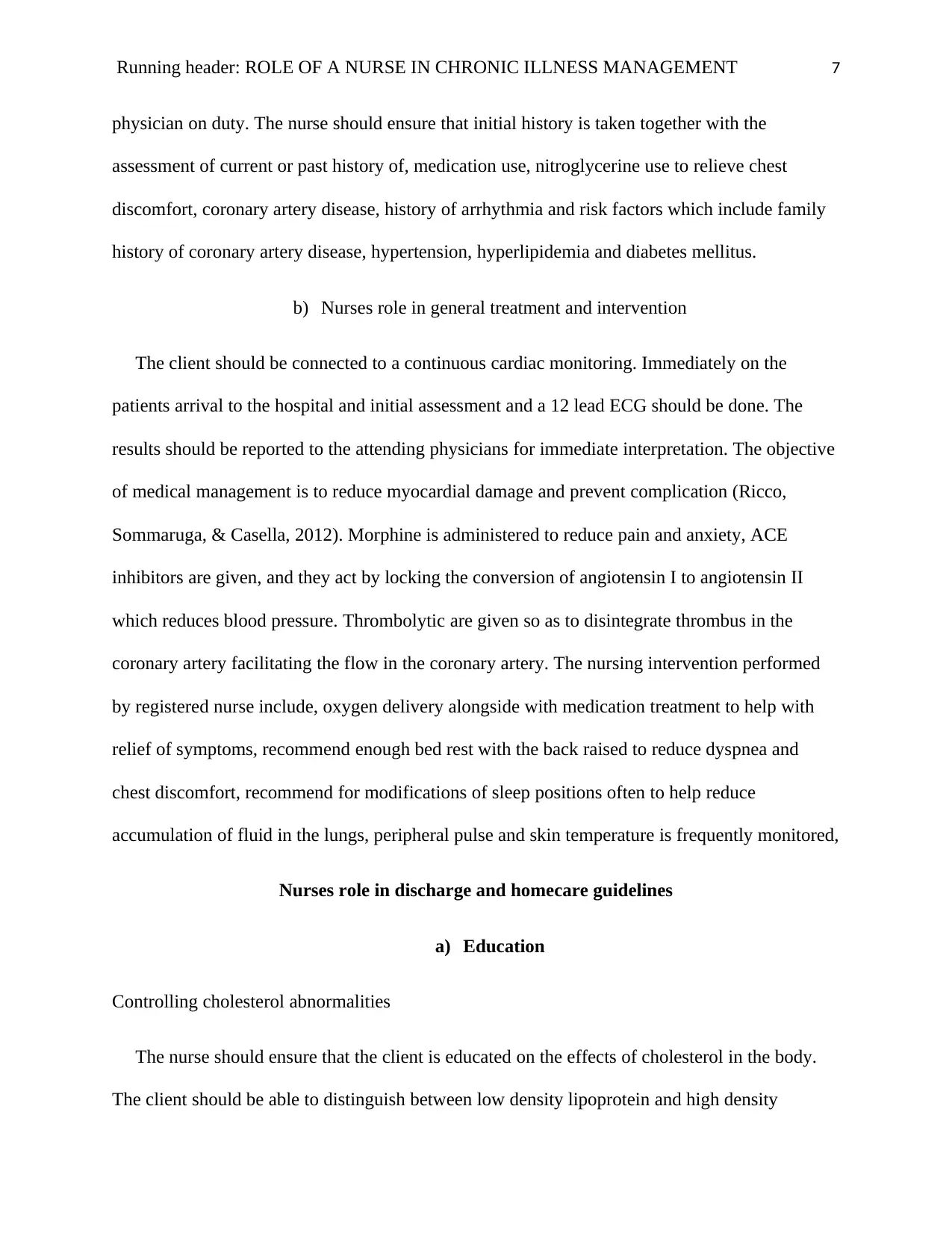
Running header: ROLE OF A NURSE IN CHRONIC ILLNESS MANAGEMENT 7
physician on duty. The nurse should ensure that initial history is taken together with the
assessment of current or past history of, medication use, nitroglycerine use to relieve chest
discomfort, coronary artery disease, history of arrhythmia and risk factors which include family
history of coronary artery disease, hypertension, hyperlipidemia and diabetes mellitus.
b) Nurses role in general treatment and intervention
The client should be connected to a continuous cardiac monitoring. Immediately on the
patients arrival to the hospital and initial assessment and a 12 lead ECG should be done. The
results should be reported to the attending physicians for immediate interpretation. The objective
of medical management is to reduce myocardial damage and prevent complication (Ricco,
Sommaruga, & Casella, 2012). Morphine is administered to reduce pain and anxiety, ACE
inhibitors are given, and they act by locking the conversion of angiotensin I to angiotensin II
which reduces blood pressure. Thrombolytic are given so as to disintegrate thrombus in the
coronary artery facilitating the flow in the coronary artery. The nursing intervention performed
by registered nurse include, oxygen delivery alongside with medication treatment to help with
relief of symptoms, recommend enough bed rest with the back raised to reduce dyspnea and
chest discomfort, recommend for modifications of sleep positions often to help reduce
accumulation of fluid in the lungs, peripheral pulse and skin temperature is frequently monitored,
Nurses role in discharge and homecare guidelines
a) Education
Controlling cholesterol abnormalities
The nurse should ensure that the client is educated on the effects of cholesterol in the body.
The client should be able to distinguish between low density lipoprotein and high density
physician on duty. The nurse should ensure that initial history is taken together with the
assessment of current or past history of, medication use, nitroglycerine use to relieve chest
discomfort, coronary artery disease, history of arrhythmia and risk factors which include family
history of coronary artery disease, hypertension, hyperlipidemia and diabetes mellitus.
b) Nurses role in general treatment and intervention
The client should be connected to a continuous cardiac monitoring. Immediately on the
patients arrival to the hospital and initial assessment and a 12 lead ECG should be done. The
results should be reported to the attending physicians for immediate interpretation. The objective
of medical management is to reduce myocardial damage and prevent complication (Ricco,
Sommaruga, & Casella, 2012). Morphine is administered to reduce pain and anxiety, ACE
inhibitors are given, and they act by locking the conversion of angiotensin I to angiotensin II
which reduces blood pressure. Thrombolytic are given so as to disintegrate thrombus in the
coronary artery facilitating the flow in the coronary artery. The nursing intervention performed
by registered nurse include, oxygen delivery alongside with medication treatment to help with
relief of symptoms, recommend enough bed rest with the back raised to reduce dyspnea and
chest discomfort, recommend for modifications of sleep positions often to help reduce
accumulation of fluid in the lungs, peripheral pulse and skin temperature is frequently monitored,
Nurses role in discharge and homecare guidelines
a) Education
Controlling cholesterol abnormalities
The nurse should ensure that the client is educated on the effects of cholesterol in the body.
The client should be able to distinguish between low density lipoprotein and high density
Paraphrase This Document
Need a fresh take? Get an instant paraphrase of this document with our AI Paraphraser
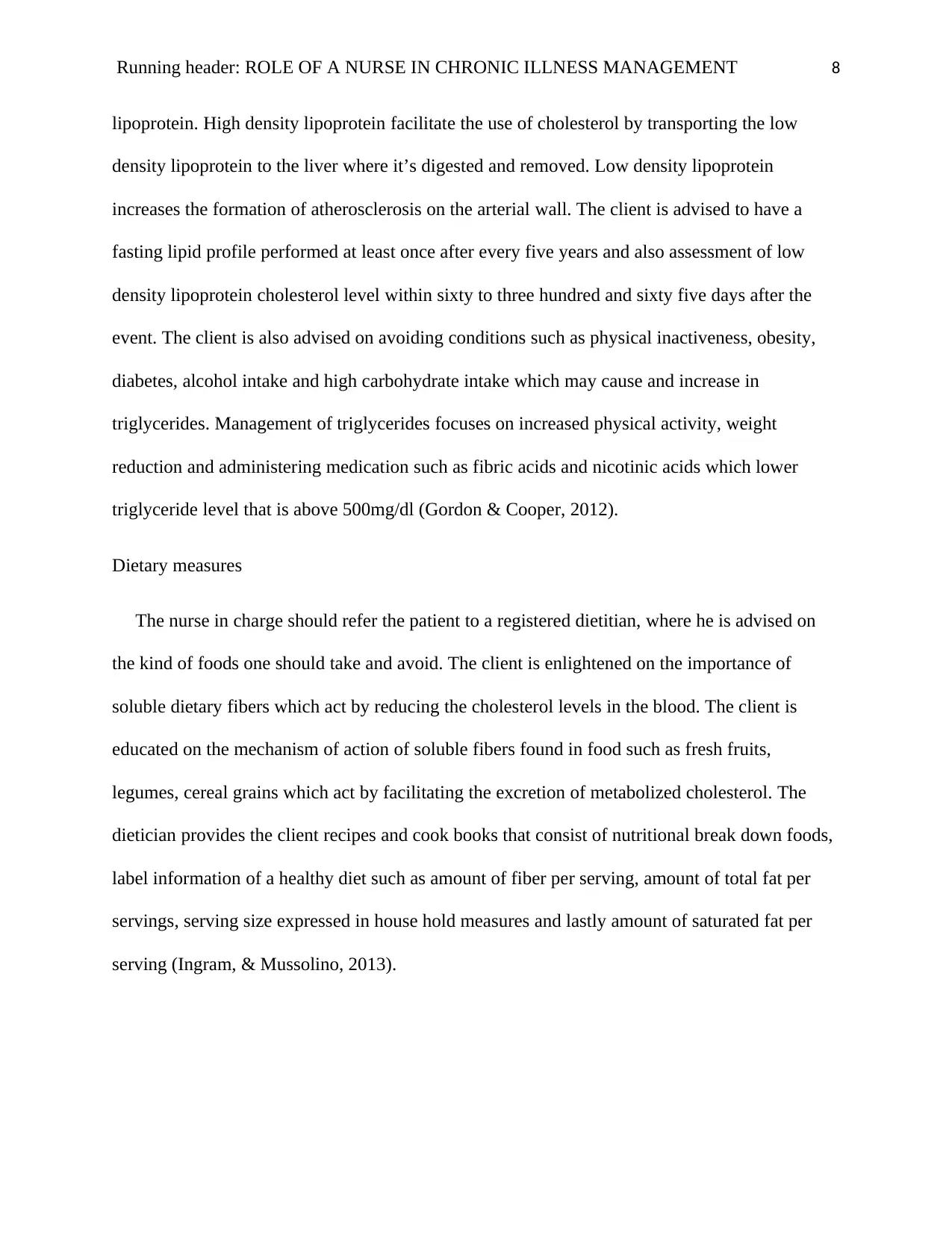
Running header: ROLE OF A NURSE IN CHRONIC ILLNESS MANAGEMENT 8
lipoprotein. High density lipoprotein facilitate the use of cholesterol by transporting the low
density lipoprotein to the liver where it’s digested and removed. Low density lipoprotein
increases the formation of atherosclerosis on the arterial wall. The client is advised to have a
fasting lipid profile performed at least once after every five years and also assessment of low
density lipoprotein cholesterol level within sixty to three hundred and sixty five days after the
event. The client is also advised on avoiding conditions such as physical inactiveness, obesity,
diabetes, alcohol intake and high carbohydrate intake which may cause and increase in
triglycerides. Management of triglycerides focuses on increased physical activity, weight
reduction and administering medication such as fibric acids and nicotinic acids which lower
triglyceride level that is above 500mg/dl (Gordon & Cooper, 2012).
Dietary measures
The nurse in charge should refer the patient to a registered dietitian, where he is advised on
the kind of foods one should take and avoid. The client is enlightened on the importance of
soluble dietary fibers which act by reducing the cholesterol levels in the blood. The client is
educated on the mechanism of action of soluble fibers found in food such as fresh fruits,
legumes, cereal grains which act by facilitating the excretion of metabolized cholesterol. The
dietician provides the client recipes and cook books that consist of nutritional break down foods,
label information of a healthy diet such as amount of fiber per serving, amount of total fat per
servings, serving size expressed in house hold measures and lastly amount of saturated fat per
serving (Ingram, & Mussolino, 2013).
lipoprotein. High density lipoprotein facilitate the use of cholesterol by transporting the low
density lipoprotein to the liver where it’s digested and removed. Low density lipoprotein
increases the formation of atherosclerosis on the arterial wall. The client is advised to have a
fasting lipid profile performed at least once after every five years and also assessment of low
density lipoprotein cholesterol level within sixty to three hundred and sixty five days after the
event. The client is also advised on avoiding conditions such as physical inactiveness, obesity,
diabetes, alcohol intake and high carbohydrate intake which may cause and increase in
triglycerides. Management of triglycerides focuses on increased physical activity, weight
reduction and administering medication such as fibric acids and nicotinic acids which lower
triglyceride level that is above 500mg/dl (Gordon & Cooper, 2012).
Dietary measures
The nurse in charge should refer the patient to a registered dietitian, where he is advised on
the kind of foods one should take and avoid. The client is enlightened on the importance of
soluble dietary fibers which act by reducing the cholesterol levels in the blood. The client is
educated on the mechanism of action of soluble fibers found in food such as fresh fruits,
legumes, cereal grains which act by facilitating the excretion of metabolized cholesterol. The
dietician provides the client recipes and cook books that consist of nutritional break down foods,
label information of a healthy diet such as amount of fiber per serving, amount of total fat per
servings, serving size expressed in house hold measures and lastly amount of saturated fat per
serving (Ingram, & Mussolino, 2013).
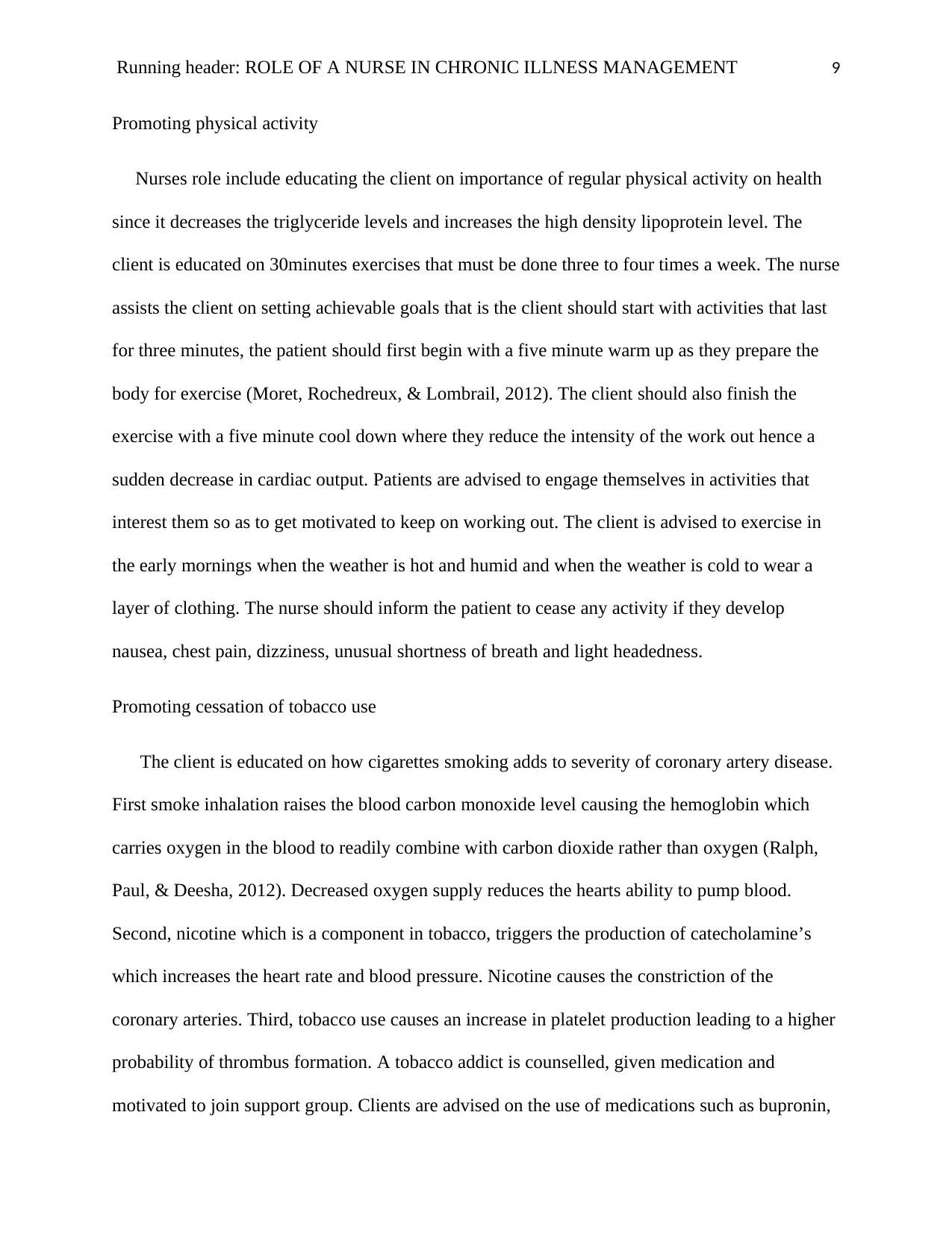
Running header: ROLE OF A NURSE IN CHRONIC ILLNESS MANAGEMENT 9
Promoting physical activity
Nurses role include educating the client on importance of regular physical activity on health
since it decreases the triglyceride levels and increases the high density lipoprotein level. The
client is educated on 30minutes exercises that must be done three to four times a week. The nurse
assists the client on setting achievable goals that is the client should start with activities that last
for three minutes, the patient should first begin with a five minute warm up as they prepare the
body for exercise (Moret, Rochedreux, & Lombrail, 2012). The client should also finish the
exercise with a five minute cool down where they reduce the intensity of the work out hence a
sudden decrease in cardiac output. Patients are advised to engage themselves in activities that
interest them so as to get motivated to keep on working out. The client is advised to exercise in
the early mornings when the weather is hot and humid and when the weather is cold to wear a
layer of clothing. The nurse should inform the patient to cease any activity if they develop
nausea, chest pain, dizziness, unusual shortness of breath and light headedness.
Promoting cessation of tobacco use
The client is educated on how cigarettes smoking adds to severity of coronary artery disease.
First smoke inhalation raises the blood carbon monoxide level causing the hemoglobin which
carries oxygen in the blood to readily combine with carbon dioxide rather than oxygen (Ralph,
Paul, & Deesha, 2012). Decreased oxygen supply reduces the hearts ability to pump blood.
Second, nicotine which is a component in tobacco, triggers the production of catecholamine’s
which increases the heart rate and blood pressure. Nicotine causes the constriction of the
coronary arteries. Third, tobacco use causes an increase in platelet production leading to a higher
probability of thrombus formation. A tobacco addict is counselled, given medication and
motivated to join support group. Clients are advised on the use of medications such as bupronin,
Promoting physical activity
Nurses role include educating the client on importance of regular physical activity on health
since it decreases the triglyceride levels and increases the high density lipoprotein level. The
client is educated on 30minutes exercises that must be done three to four times a week. The nurse
assists the client on setting achievable goals that is the client should start with activities that last
for three minutes, the patient should first begin with a five minute warm up as they prepare the
body for exercise (Moret, Rochedreux, & Lombrail, 2012). The client should also finish the
exercise with a five minute cool down where they reduce the intensity of the work out hence a
sudden decrease in cardiac output. Patients are advised to engage themselves in activities that
interest them so as to get motivated to keep on working out. The client is advised to exercise in
the early mornings when the weather is hot and humid and when the weather is cold to wear a
layer of clothing. The nurse should inform the patient to cease any activity if they develop
nausea, chest pain, dizziness, unusual shortness of breath and light headedness.
Promoting cessation of tobacco use
The client is educated on how cigarettes smoking adds to severity of coronary artery disease.
First smoke inhalation raises the blood carbon monoxide level causing the hemoglobin which
carries oxygen in the blood to readily combine with carbon dioxide rather than oxygen (Ralph,
Paul, & Deesha, 2012). Decreased oxygen supply reduces the hearts ability to pump blood.
Second, nicotine which is a component in tobacco, triggers the production of catecholamine’s
which increases the heart rate and blood pressure. Nicotine causes the constriction of the
coronary arteries. Third, tobacco use causes an increase in platelet production leading to a higher
probability of thrombus formation. A tobacco addict is counselled, given medication and
motivated to join support group. Clients are advised on the use of medications such as bupronin,

Running header: ROLE OF A NURSE IN CHRONIC ILLNESS MANAGEMENT
10
nicotine patch which may help stop the use of tobacco (Stead, Buitrago, Preciado, & Sanchez,
2013).
Gender and estrogen level
Women are more likely to be affected with coronary artery diseases than men this is because
women tend not to recognize the signs and symptoms early so as to seek medical assistance
(Stramba, 2014). Women of age 55 years and above are recommended to seek hormone
replacement therapy for menopausal women (Morley & Perry, 2013).
Self-administration of nitroglycerine
Most clients with myocardial infarction take nitroglycerine on a daily basis. The nursing role
in such cases is educating the patients about the medication and how to take it. The client is
instructed to make sure the mouth is moist and saliva is not swallowed until the nitroglycerine
tablet is dissolved (Kaplan, Taber, & Davison, 2103). The client is advised on the storage
condition of the drug, nitroglycerine is very unstable hence it should be in a dark container,
nitroglycerine is volatile and can be easily be inactivated by light, heat and moisture therefore it
should be renewed after every six months (Fye & Bruce, 2013). The client is informed that the
drugs are only taken when the individual wants to do any activity that may produce pain such as
sexual intercourse, stairclimbing and exercise. The client is advised to note how long it takes for
the nitroglycerine to relieve discomfort. The patient is advised if the pain persists, emergency
medical services should be called.
10
nicotine patch which may help stop the use of tobacco (Stead, Buitrago, Preciado, & Sanchez,
2013).
Gender and estrogen level
Women are more likely to be affected with coronary artery diseases than men this is because
women tend not to recognize the signs and symptoms early so as to seek medical assistance
(Stramba, 2014). Women of age 55 years and above are recommended to seek hormone
replacement therapy for menopausal women (Morley & Perry, 2013).
Self-administration of nitroglycerine
Most clients with myocardial infarction take nitroglycerine on a daily basis. The nursing role
in such cases is educating the patients about the medication and how to take it. The client is
instructed to make sure the mouth is moist and saliva is not swallowed until the nitroglycerine
tablet is dissolved (Kaplan, Taber, & Davison, 2103). The client is advised on the storage
condition of the drug, nitroglycerine is very unstable hence it should be in a dark container,
nitroglycerine is volatile and can be easily be inactivated by light, heat and moisture therefore it
should be renewed after every six months (Fye & Bruce, 2013). The client is informed that the
drugs are only taken when the individual wants to do any activity that may produce pain such as
sexual intercourse, stairclimbing and exercise. The client is advised to note how long it takes for
the nitroglycerine to relieve discomfort. The patient is advised if the pain persists, emergency
medical services should be called.
Secure Best Marks with AI Grader
Need help grading? Try our AI Grader for instant feedback on your assignments.
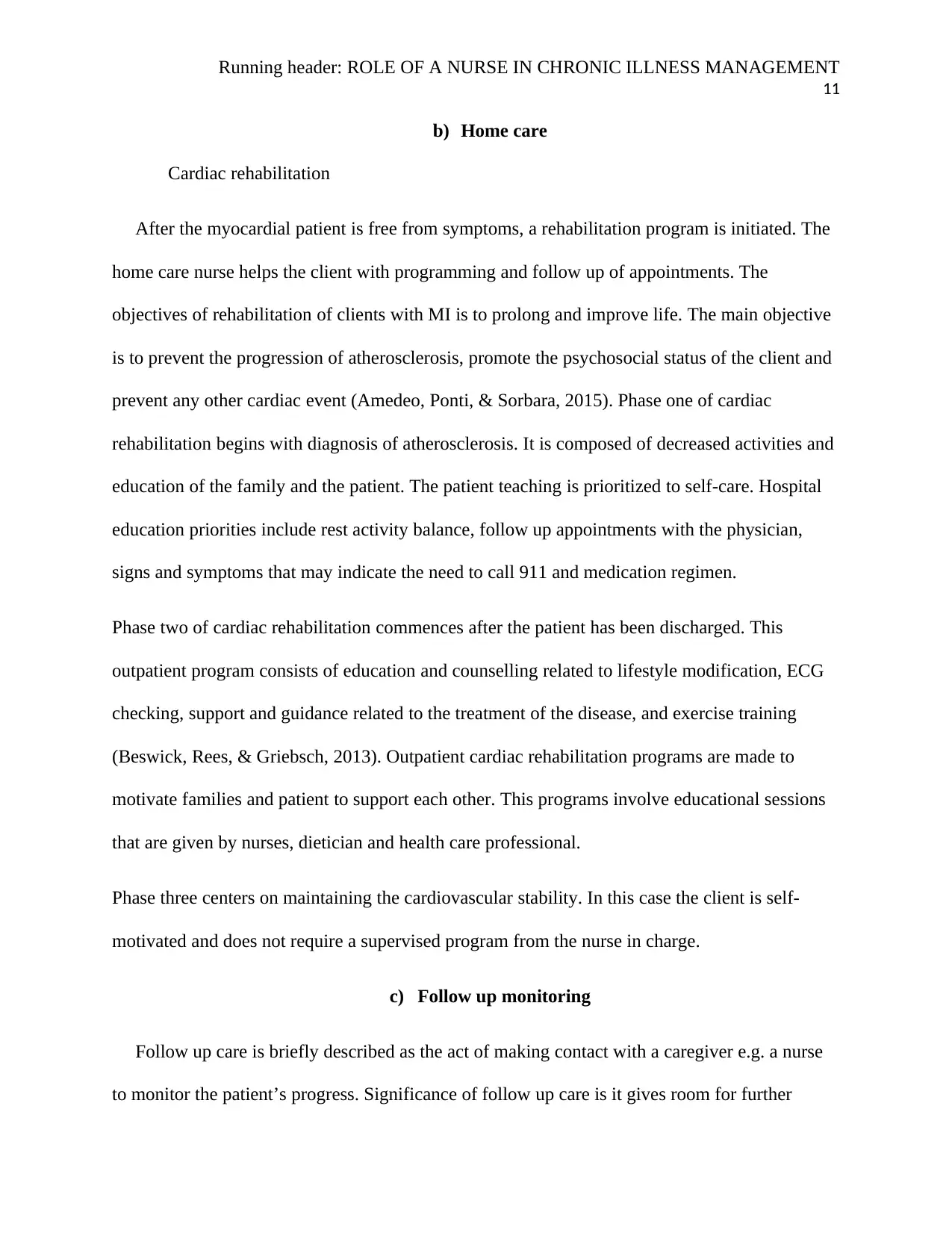
Running header: ROLE OF A NURSE IN CHRONIC ILLNESS MANAGEMENT
11
b) Home care
Cardiac rehabilitation
After the myocardial patient is free from symptoms, a rehabilitation program is initiated. The
home care nurse helps the client with programming and follow up of appointments. The
objectives of rehabilitation of clients with MI is to prolong and improve life. The main objective
is to prevent the progression of atherosclerosis, promote the psychosocial status of the client and
prevent any other cardiac event (Amedeo, Ponti, & Sorbara, 2015). Phase one of cardiac
rehabilitation begins with diagnosis of atherosclerosis. It is composed of decreased activities and
education of the family and the patient. The patient teaching is prioritized to self-care. Hospital
education priorities include rest activity balance, follow up appointments with the physician,
signs and symptoms that may indicate the need to call 911 and medication regimen.
Phase two of cardiac rehabilitation commences after the patient has been discharged. This
outpatient program consists of education and counselling related to lifestyle modification, ECG
checking, support and guidance related to the treatment of the disease, and exercise training
(Beswick, Rees, & Griebsch, 2013). Outpatient cardiac rehabilitation programs are made to
motivate families and patient to support each other. This programs involve educational sessions
that are given by nurses, dietician and health care professional.
Phase three centers on maintaining the cardiovascular stability. In this case the client is self-
motivated and does not require a supervised program from the nurse in charge.
c) Follow up monitoring
Follow up care is briefly described as the act of making contact with a caregiver e.g. a nurse
to monitor the patient’s progress. Significance of follow up care is it gives room for further
11
b) Home care
Cardiac rehabilitation
After the myocardial patient is free from symptoms, a rehabilitation program is initiated. The
home care nurse helps the client with programming and follow up of appointments. The
objectives of rehabilitation of clients with MI is to prolong and improve life. The main objective
is to prevent the progression of atherosclerosis, promote the psychosocial status of the client and
prevent any other cardiac event (Amedeo, Ponti, & Sorbara, 2015). Phase one of cardiac
rehabilitation begins with diagnosis of atherosclerosis. It is composed of decreased activities and
education of the family and the patient. The patient teaching is prioritized to self-care. Hospital
education priorities include rest activity balance, follow up appointments with the physician,
signs and symptoms that may indicate the need to call 911 and medication regimen.
Phase two of cardiac rehabilitation commences after the patient has been discharged. This
outpatient program consists of education and counselling related to lifestyle modification, ECG
checking, support and guidance related to the treatment of the disease, and exercise training
(Beswick, Rees, & Griebsch, 2013). Outpatient cardiac rehabilitation programs are made to
motivate families and patient to support each other. This programs involve educational sessions
that are given by nurses, dietician and health care professional.
Phase three centers on maintaining the cardiovascular stability. In this case the client is self-
motivated and does not require a supervised program from the nurse in charge.
c) Follow up monitoring
Follow up care is briefly described as the act of making contact with a caregiver e.g. a nurse
to monitor the patient’s progress. Significance of follow up care is it gives room for further
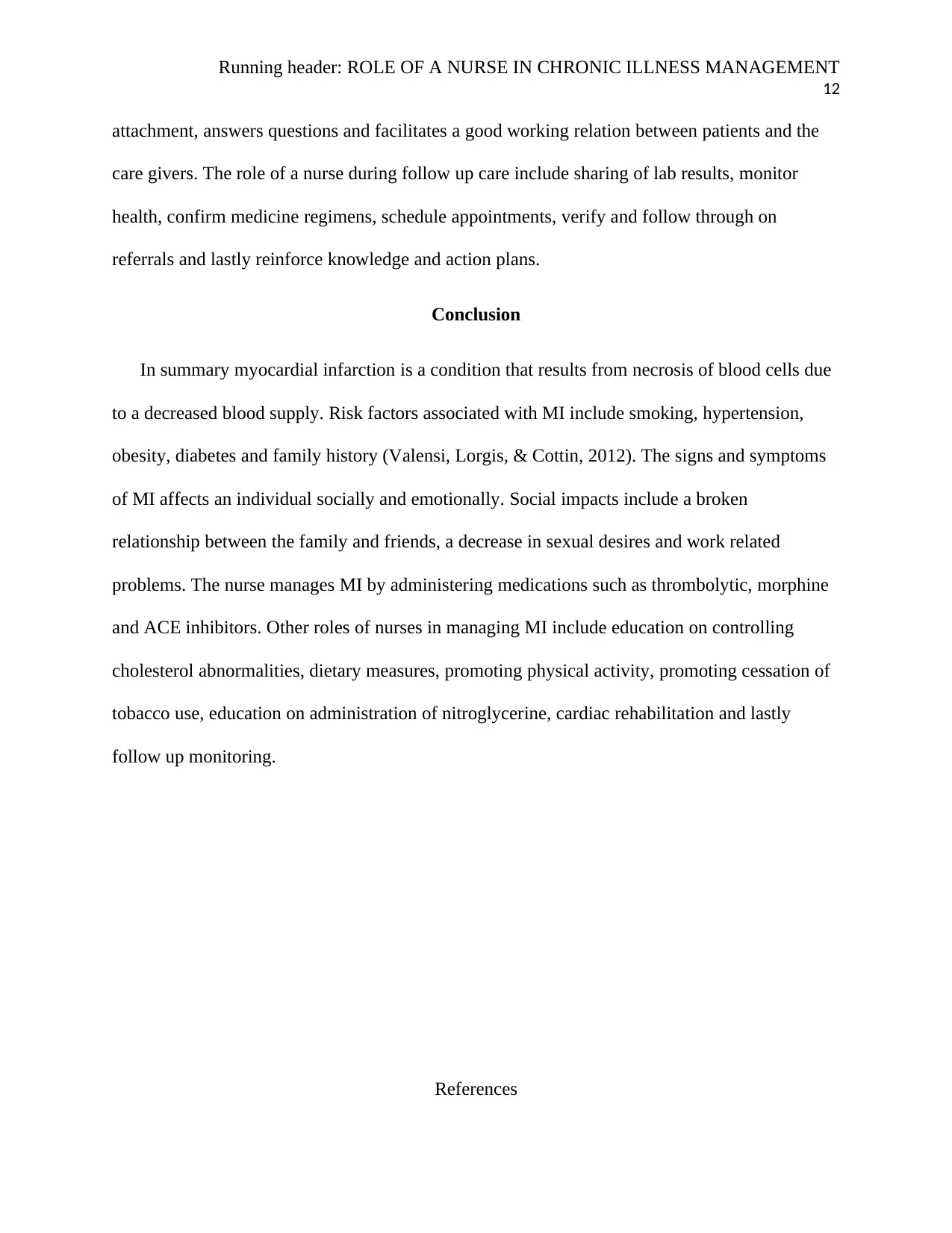
Running header: ROLE OF A NURSE IN CHRONIC ILLNESS MANAGEMENT
12
attachment, answers questions and facilitates a good working relation between patients and the
care givers. The role of a nurse during follow up care include sharing of lab results, monitor
health, confirm medicine regimens, schedule appointments, verify and follow through on
referrals and lastly reinforce knowledge and action plans.
Conclusion
In summary myocardial infarction is a condition that results from necrosis of blood cells due
to a decreased blood supply. Risk factors associated with MI include smoking, hypertension,
obesity, diabetes and family history (Valensi, Lorgis, & Cottin, 2012). The signs and symptoms
of MI affects an individual socially and emotionally. Social impacts include a broken
relationship between the family and friends, a decrease in sexual desires and work related
problems. The nurse manages MI by administering medications such as thrombolytic, morphine
and ACE inhibitors. Other roles of nurses in managing MI include education on controlling
cholesterol abnormalities, dietary measures, promoting physical activity, promoting cessation of
tobacco use, education on administration of nitroglycerine, cardiac rehabilitation and lastly
follow up monitoring.
References
12
attachment, answers questions and facilitates a good working relation between patients and the
care givers. The role of a nurse during follow up care include sharing of lab results, monitor
health, confirm medicine regimens, schedule appointments, verify and follow through on
referrals and lastly reinforce knowledge and action plans.
Conclusion
In summary myocardial infarction is a condition that results from necrosis of blood cells due
to a decreased blood supply. Risk factors associated with MI include smoking, hypertension,
obesity, diabetes and family history (Valensi, Lorgis, & Cottin, 2012). The signs and symptoms
of MI affects an individual socially and emotionally. Social impacts include a broken
relationship between the family and friends, a decrease in sexual desires and work related
problems. The nurse manages MI by administering medications such as thrombolytic, morphine
and ACE inhibitors. Other roles of nurses in managing MI include education on controlling
cholesterol abnormalities, dietary measures, promoting physical activity, promoting cessation of
tobacco use, education on administration of nitroglycerine, cardiac rehabilitation and lastly
follow up monitoring.
References
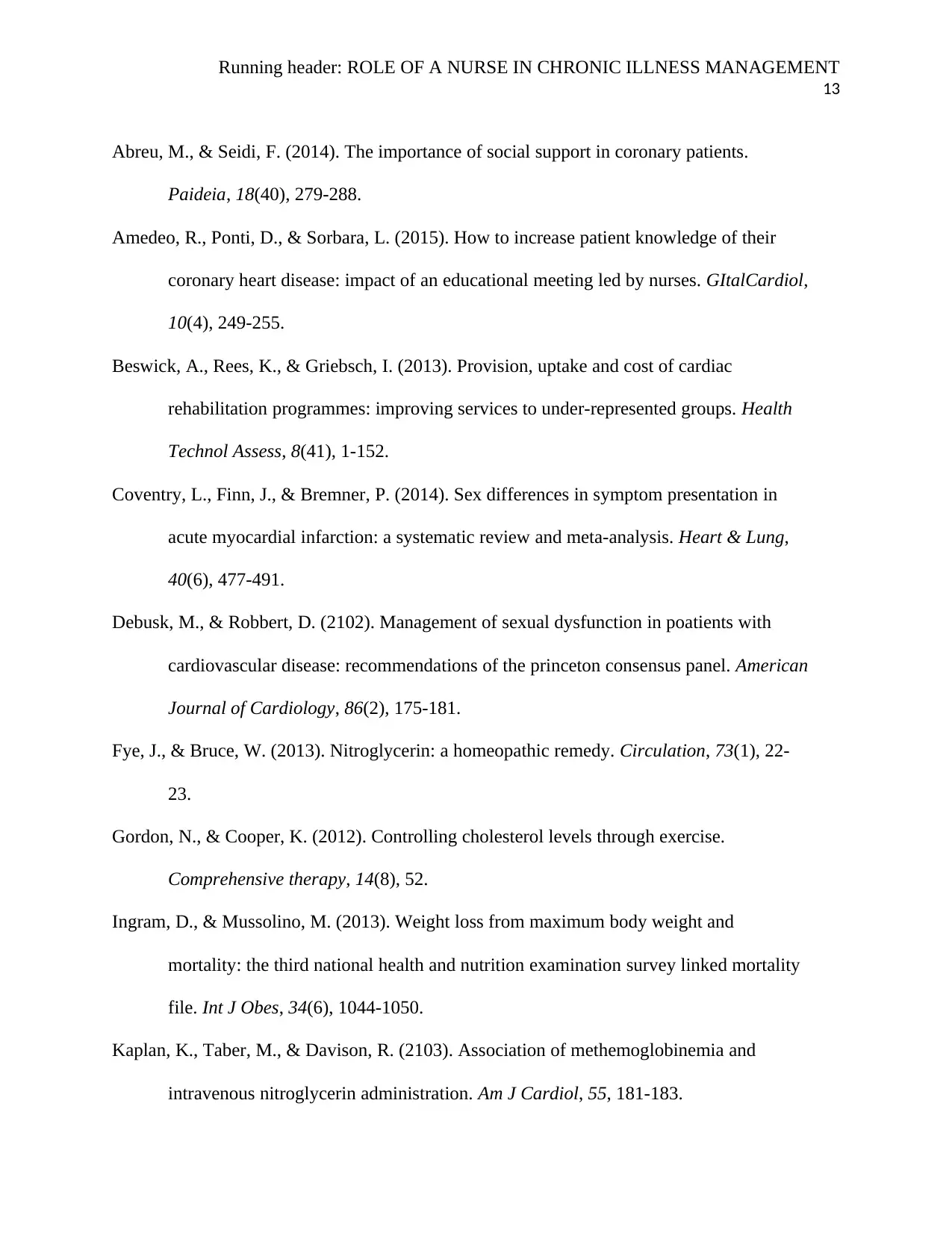
Running header: ROLE OF A NURSE IN CHRONIC ILLNESS MANAGEMENT
13
Abreu, M., & Seidi, F. (2014). The importance of social support in coronary patients.
Paideia, 18(40), 279-288.
Amedeo, R., Ponti, D., & Sorbara, L. (2015). How to increase patient knowledge of their
coronary heart disease: impact of an educational meeting led by nurses. GItalCardiol,
10(4), 249-255.
Beswick, A., Rees, K., & Griebsch, I. (2013). Provision, uptake and cost of cardiac
rehabilitation programmes: improving services to under-represented groups. Health
Technol Assess, 8(41), 1-152.
Coventry, L., Finn, J., & Bremner, P. (2014). Sex differences in symptom presentation in
acute myocardial infarction: a systematic review and meta-analysis. Heart & Lung,
40(6), 477-491.
Debusk, M., & Robbert, D. (2102). Management of sexual dysfunction in poatients with
cardiovascular disease: recommendations of the princeton consensus panel. American
Journal of Cardiology, 86(2), 175-181.
Fye, J., & Bruce, W. (2013). Nitroglycerin: a homeopathic remedy. Circulation, 73(1), 22-
23.
Gordon, N., & Cooper, K. (2012). Controlling cholesterol levels through exercise.
Comprehensive therapy, 14(8), 52.
Ingram, D., & Mussolino, M. (2013). Weight loss from maximum body weight and
mortality: the third national health and nutrition examination survey linked mortality
file. Int J Obes, 34(6), 1044-1050.
Kaplan, K., Taber, M., & Davison, R. (2103). Association of methemoglobinemia and
intravenous nitroglycerin administration. Am J Cardiol, 55, 181-183.
13
Abreu, M., & Seidi, F. (2014). The importance of social support in coronary patients.
Paideia, 18(40), 279-288.
Amedeo, R., Ponti, D., & Sorbara, L. (2015). How to increase patient knowledge of their
coronary heart disease: impact of an educational meeting led by nurses. GItalCardiol,
10(4), 249-255.
Beswick, A., Rees, K., & Griebsch, I. (2013). Provision, uptake and cost of cardiac
rehabilitation programmes: improving services to under-represented groups. Health
Technol Assess, 8(41), 1-152.
Coventry, L., Finn, J., & Bremner, P. (2014). Sex differences in symptom presentation in
acute myocardial infarction: a systematic review and meta-analysis. Heart & Lung,
40(6), 477-491.
Debusk, M., & Robbert, D. (2102). Management of sexual dysfunction in poatients with
cardiovascular disease: recommendations of the princeton consensus panel. American
Journal of Cardiology, 86(2), 175-181.
Fye, J., & Bruce, W. (2013). Nitroglycerin: a homeopathic remedy. Circulation, 73(1), 22-
23.
Gordon, N., & Cooper, K. (2012). Controlling cholesterol levels through exercise.
Comprehensive therapy, 14(8), 52.
Ingram, D., & Mussolino, M. (2013). Weight loss from maximum body weight and
mortality: the third national health and nutrition examination survey linked mortality
file. Int J Obes, 34(6), 1044-1050.
Kaplan, K., Taber, M., & Davison, R. (2103). Association of methemoglobinemia and
intravenous nitroglycerin administration. Am J Cardiol, 55, 181-183.
Paraphrase This Document
Need a fresh take? Get an instant paraphrase of this document with our AI Paraphraser
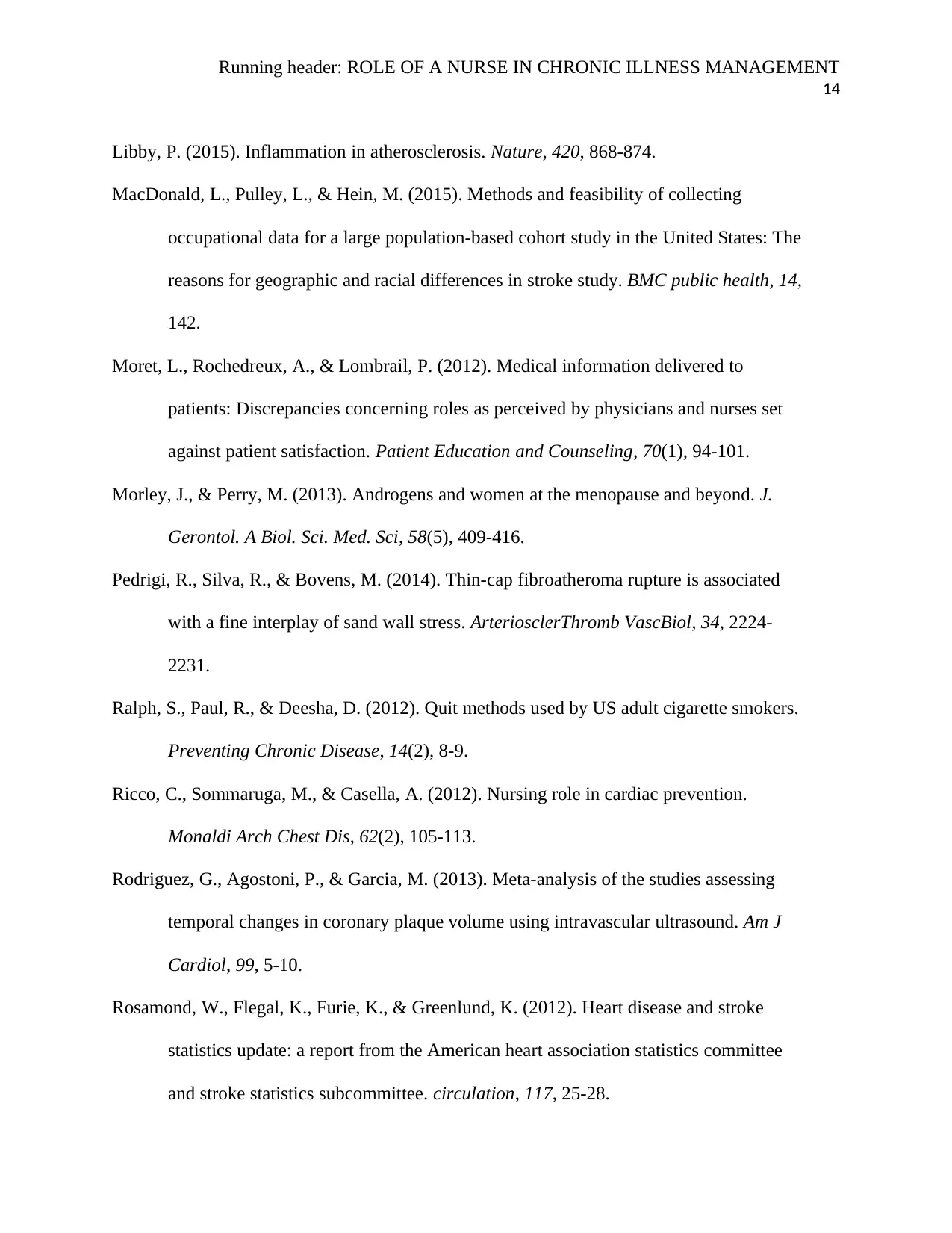
Running header: ROLE OF A NURSE IN CHRONIC ILLNESS MANAGEMENT
14
Libby, P. (2015). Inflammation in atherosclerosis. Nature, 420, 868-874.
MacDonald, L., Pulley, L., & Hein, M. (2015). Methods and feasibility of collecting
occupational data for a large population-based cohort study in the United States: The
reasons for geographic and racial differences in stroke study. BMC public health, 14,
142.
Moret, L., Rochedreux, A., & Lombrail, P. (2012). Medical information delivered to
patients: Discrepancies concerning roles as perceived by physicians and nurses set
against patient satisfaction. Patient Education and Counseling, 70(1), 94-101.
Morley, J., & Perry, M. (2013). Androgens and women at the menopause and beyond. J.
Gerontol. A Biol. Sci. Med. Sci, 58(5), 409-416.
Pedrigi, R., Silva, R., & Bovens, M. (2014). Thin-cap fibroatheroma rupture is associated
with a fine interplay of sand wall stress. ArteriosclerThromb VascBiol, 34, 2224-
2231.
Ralph, S., Paul, R., & Deesha, D. (2012). Quit methods used by US adult cigarette smokers.
Preventing Chronic Disease, 14(2), 8-9.
Ricco, C., Sommaruga, M., & Casella, A. (2012). Nursing role in cardiac prevention.
Monaldi Arch Chest Dis, 62(2), 105-113.
Rodriguez, G., Agostoni, P., & Garcia, M. (2013). Meta-analysis of the studies assessing
temporal changes in coronary plaque volume using intravascular ultrasound. Am J
Cardiol, 99, 5-10.
Rosamond, W., Flegal, K., Furie, K., & Greenlund, K. (2012). Heart disease and stroke
statistics update: a report from the American heart association statistics committee
and stroke statistics subcommittee. circulation, 117, 25-28.
14
Libby, P. (2015). Inflammation in atherosclerosis. Nature, 420, 868-874.
MacDonald, L., Pulley, L., & Hein, M. (2015). Methods and feasibility of collecting
occupational data for a large population-based cohort study in the United States: The
reasons for geographic and racial differences in stroke study. BMC public health, 14,
142.
Moret, L., Rochedreux, A., & Lombrail, P. (2012). Medical information delivered to
patients: Discrepancies concerning roles as perceived by physicians and nurses set
against patient satisfaction. Patient Education and Counseling, 70(1), 94-101.
Morley, J., & Perry, M. (2013). Androgens and women at the menopause and beyond. J.
Gerontol. A Biol. Sci. Med. Sci, 58(5), 409-416.
Pedrigi, R., Silva, R., & Bovens, M. (2014). Thin-cap fibroatheroma rupture is associated
with a fine interplay of sand wall stress. ArteriosclerThromb VascBiol, 34, 2224-
2231.
Ralph, S., Paul, R., & Deesha, D. (2012). Quit methods used by US adult cigarette smokers.
Preventing Chronic Disease, 14(2), 8-9.
Ricco, C., Sommaruga, M., & Casella, A. (2012). Nursing role in cardiac prevention.
Monaldi Arch Chest Dis, 62(2), 105-113.
Rodriguez, G., Agostoni, P., & Garcia, M. (2013). Meta-analysis of the studies assessing
temporal changes in coronary plaque volume using intravascular ultrasound. Am J
Cardiol, 99, 5-10.
Rosamond, W., Flegal, K., Furie, K., & Greenlund, K. (2012). Heart disease and stroke
statistics update: a report from the American heart association statistics committee
and stroke statistics subcommittee. circulation, 117, 25-28.
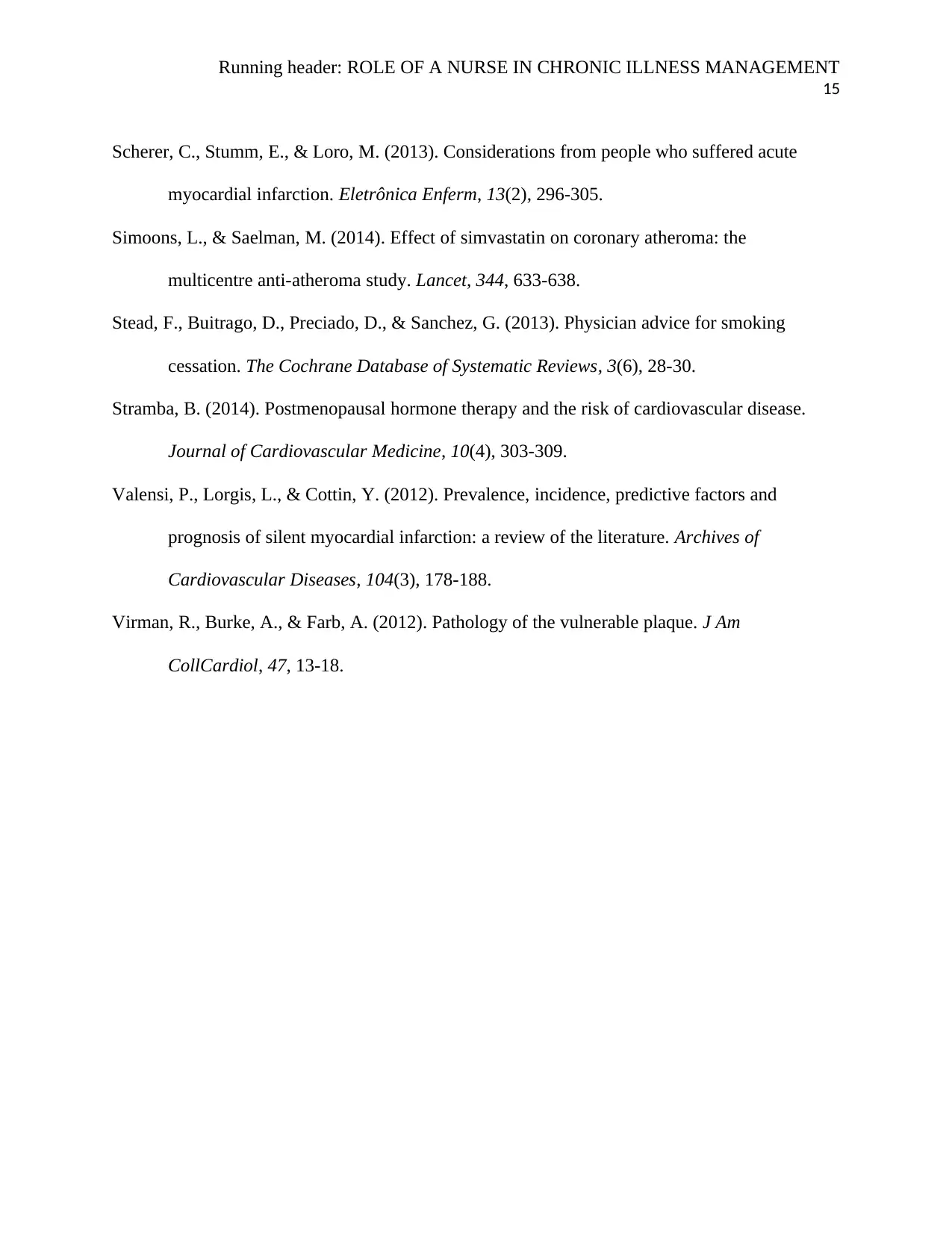
Running header: ROLE OF A NURSE IN CHRONIC ILLNESS MANAGEMENT
15
Scherer, C., Stumm, E., & Loro, M. (2013). Considerations from people who suffered acute
myocardial infarction. Eletrônica Enferm, 13(2), 296-305.
Simoons, L., & Saelman, M. (2014). Effect of simvastatin on coronary atheroma: the
multicentre anti-atheroma study. Lancet, 344, 633-638.
Stead, F., Buitrago, D., Preciado, D., & Sanchez, G. (2013). Physician advice for smoking
cessation. The Cochrane Database of Systematic Reviews, 3(6), 28-30.
Stramba, B. (2014). Postmenopausal hormone therapy and the risk of cardiovascular disease.
Journal of Cardiovascular Medicine, 10(4), 303-309.
Valensi, P., Lorgis, L., & Cottin, Y. (2012). Prevalence, incidence, predictive factors and
prognosis of silent myocardial infarction: a review of the literature. Archives of
Cardiovascular Diseases, 104(3), 178-188.
Virman, R., Burke, A., & Farb, A. (2012). Pathology of the vulnerable plaque. J Am
CollCardiol, 47, 13-18.
15
Scherer, C., Stumm, E., & Loro, M. (2013). Considerations from people who suffered acute
myocardial infarction. Eletrônica Enferm, 13(2), 296-305.
Simoons, L., & Saelman, M. (2014). Effect of simvastatin on coronary atheroma: the
multicentre anti-atheroma study. Lancet, 344, 633-638.
Stead, F., Buitrago, D., Preciado, D., & Sanchez, G. (2013). Physician advice for smoking
cessation. The Cochrane Database of Systematic Reviews, 3(6), 28-30.
Stramba, B. (2014). Postmenopausal hormone therapy and the risk of cardiovascular disease.
Journal of Cardiovascular Medicine, 10(4), 303-309.
Valensi, P., Lorgis, L., & Cottin, Y. (2012). Prevalence, incidence, predictive factors and
prognosis of silent myocardial infarction: a review of the literature. Archives of
Cardiovascular Diseases, 104(3), 178-188.
Virman, R., Burke, A., & Farb, A. (2012). Pathology of the vulnerable plaque. J Am
CollCardiol, 47, 13-18.
1 out of 15
Related Documents
Your All-in-One AI-Powered Toolkit for Academic Success.
+13062052269
info@desklib.com
Available 24*7 on WhatsApp / Email
![[object Object]](/_next/static/media/star-bottom.7253800d.svg)
Unlock your academic potential
© 2024 | Zucol Services PVT LTD | All rights reserved.





